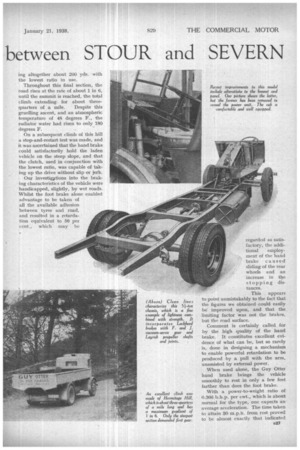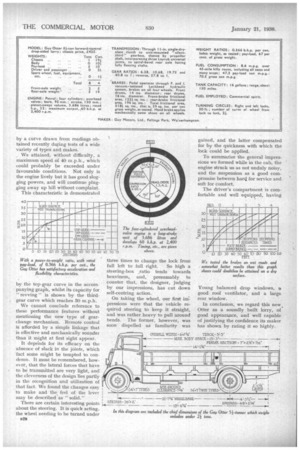WITH an OTTEF between STOUR and SEVERN
Page 12

Page 13

Page 14

If you've noticed an error in this article please click here to report it so we can fix it.
A Hard Day's Test of a Guy 5i-tanner, One of the Highest-rated Machines' in the 50-cwt. Class, Reveals Many Good Features Aat a contour
map shows the undulating
nature of the country between Wolverhampton and Bridgnorth. The road linking these two towns rises and falls continually and terminates at its western extremity with a steep 4-mi1e drop, known. as Hermitage Hill, into the Severn Valley. As a course for a commercial-vehicle consumption test it is definitely of more than average severity.
A return, therefore, obtained from a trial comprising a double journey over this route, will be, at the least, a reliable figure.
In conducting a road test of one of the new Guy Otter 51-tonners, last week, we were induced, by circumstances, to include in our consumption test, not only this route, but also a second climb of Hermitage Hill, an ascent of Windmill Bank near Essington (a few miles to the north-east of Wolverhampton), and a maze of cross-cutting roads on the outskirts of the latter town. GLANCE In addition, it embraced acceleration and retardation trials, posing for photographs and the whole of the • day's stopping, starting, reversing, and so forth. Furthermore, no attempt was made to maintain a. constant 29 m.p.h. as might be done.
526
The figure recorded, 8M m.p.g., can, therefore, be regarded as a minimum .-mileage rate,. and, although lower than returns we have obtained. on former occasions for similar vehicles, an d below average for the class, it is, nevertheless, creditable when due allowance is made for the conditions described.
On setting out from the works of Guy Motors, Ltd., at Fallings Park, Wolverhampton, we had a brimming tank. On our return, after a 45-mile run, 51 gallons were required to bring its contents to the original level.
One of the few goods vehicles rated at 54-tons, that fall within the 30 m.p.h. class, this new Guy Otter is a sturdily built machine, affording ample accommodation for its load and capable of an excellent all-round performance.
Its hill-climbing powers are definitely noteworthy. We first made an observed ascent of
Windmill Bank, mentioned above, which has a maximum gradient of about 1 in S. Third gear was demanded by the earlier stretches of this acclivity and "second" was
necessitated. as the slope stiffened. Whilst 7 m.p.h was the lowest speed touched, our rate of progress rose steadily from the moment this ratio was engaged.
Dissatisfied with this hill as a means for demonstrating the powers of the Otter, we went, by devious ways, to the •Bridgnorth road, and headed for the well-known Hermitage Hill. This was descended, and a turn made in the town, from which no opportunity is afforded of attaining a high speed before the gradient is encountered.
We were doing only 12 m.p.h. when the ascent began, and shortly had to drop from third into second gear, proceeding at a speed slowly falling from 10 m.p.h. The first cutting was thus negotiated and the second reached before the lowest ratio was needed.
After the change had been made, we proceeded at approximately 5 m.p.h. with power in. hand, cover ing altogether about 200 yds. with the lowest ratio in use.
Throughout this final section, the road rises at the rate of about 1 in 6, until the summit is reached, the total climb extending, for about three
quarters of a mile. Despite this gruelling ascent, and an atmospheric temperature of 48 degrees F., the radiator water had risen to only 180 degrees F.
On a subsequent climb of this hill a stop-and-restart test was made, and it was ascertained that the hand brake could satisfactorily hold the laden vehicle on the steep slope, and that the clutch, used in conjunction with the lowest ratio, was capable of taking up the drive without slip or jerk.
Ou,r investiggions into the braking characteristics of the vehicle were handicapped, slightly, by wet roads. Whilst the foot brake alone enabled advantage to be taken of all the available adhesion between tyres and road, and resulted in a retardation equivalent to 50 per cent., which may he regarded as satisfactory, the additional employment of the hand brake caused sliding of the rear wheels and an increase in the stopping distances.
This appears to point unmistakably to the fact that the figures we obtained could easily be improved upon, and that the limiting factor was not the brakes, but the road surface.
Comment is certainly called for by the high quality of the hand brake. It constitutes excellent evidence of what can be, but so rarely is, done in designing a mechanism to enable powerful retardation to be produced by a pull with the arm, unassisted by external power.
When used alone, the Guy Otter hand brake brings the vehicle smoothly to rest in only a few feet farther than does the foot brake.
With a power-to-weight ratio of 0.366 b.h.p. per cwt., which is about normal for the type, one expects an average acceleration. The time taken to attain 30 m.p.h. from rest proved to be almost exactly that indicated by a curve drawn from readings obtained recently during tests of a wide variety of types and makes.
We attained, without difficulty, a maximum speed of 40 m.p.h., which could probably be exceeded under favourable conditions. Not only is the engine lively but it has good slogging powers, and will continue plugging away up hill without complaint.
This characteristic is demonstrated by the top-gear curve in the accompanying graiih, whilst its capacity for " revving " is shown by the thirdgear curve which reaches 30 m.p.h.
We cannot conclude reference to these performance features without mentioning the new type of gearchange mechanism. Remote control is afforded by a simple linkage that is effective and mechanically sounder than it might at first sight appear. It depends for its efficacy on the absence of slack in the joints, which fact some might be tempted to condemn. It must be remembered, however, that the lateral forces that have to 136 transmitted are very fight, and the cleverness of the design lies partly in the recognition and utilization of that fact. We found the changes easy to make and the feel of the lever may be described as "solid."
There are certain interesting points about the steering. It is quick acting, the wheel needing to be turned under 828 three times to change the lock from full left to full right. So high a steering-box ,ratio tends towards heaviness, and, presumably to counter that, the designer, judging by our impressions, has cut down self-centring action.
On taking the wheel, our first impressions were that the vehicle required steering to keep it straight, and was rather heavy to pull around bends. The former, however, was soon dispelled as familarity was gained, and the latter compensated for by the quickness with which the lock could be applied.
To summarize the general impressions we formed while in the cab, the engine struck us as not unduly noisy, and the suspension as a good compromise between hard for service and soft for comfort.
The driver's compartment is comfortable and well equipped, having Young balanced drop windows, a good roof ventilator, and a large rear window.
In conclusion, we regard this new Otter as a soundly built lorry, of good appearance, and well capable of justifying the confidence its maker has shown by rating it so highly.






























